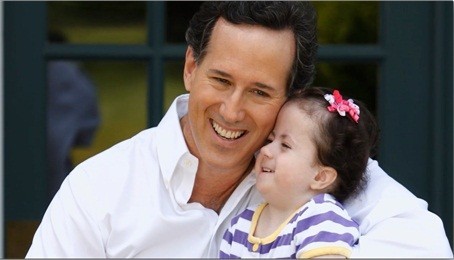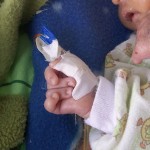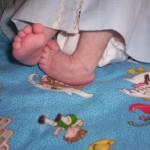Rick Santorum’s Daughter Hospitalized

Republican Presidential candidate Rick Santorum had to leave the campaign trail when his 3 yr old daughter Isabella (Bella) had to be hospitalized. Bella has a serious genetic disorder called Trisomy 18, and was admitted to Children’s Hospital of Philadelphia with pneumonia in both lungs. According to Hogan Gidley, Santorum’s National Communications Director:
“Rick and his wife Karen are admitting their daughter Bella to Children’s Hospital of Philadelphia this evening. The campaign will cancel Rick’s upcoming Sunday morning Florida campaign schedule. However, Rick intends to return to Florida and resume the campaign schedule as soon as is possible.
Bella is the youngest of the seven Santorum children. It was noticed at birth that she was “different” and at five days of age, Santorum and his wife Karen were given the diagnosis of Trisomy 18, meaning that their baby had 3 copies of chromosome 18 rather than the normal 2 copies. They were also told that the life expectancy of children with Trisomy 18 was usually very short and that she would probably not live more than a year. Despite these predictions, the Santorums told doctors that “we were not going to concentrate on her dying, we’re going to concentrate on her living, and do everything we can to help her.” Despite frequently hospitalizations, especially during her first year of life, Santorum remains upbeat:
Some people describe people like Bellas as disabled children…I look at the joy, the simplicity and the love that she emits and its clear to me that we’re the disabled ones. Not her…she’s got it right.
Reports from later today indicate that Bella is “improving” and is not on a respirator.
We wish her a speedy recovery.
What is a Trisomy?
The nucleus is the control center of human cells. It contains the genetic material- DNA- which codes for who we are. The DNA is organized into units called chromosomes. Humans have 23 pairs of chromosomes (46 chromosomes in total). One set of each pair comes from your mother (egg), the other from your father (sperm).
If the chromosome pairs fail to separate properly during cell division the egg or sperm may have a second copy of one of the chromosomes. If this egg or sperm results is fertilized and becomes an embryo, the embryo may also have an entire copy of the extra chromosome. This is called a trisomy, as the individual has 47 chromosomes.
Trisomies can occur with any chromosome, but often result in miscarriage. For example, Trisomy 16 is the most common trisomy in humans, occurring in more than 1% of pregnancies. This condition, however, usually results in spontaneous miscarriage in the first trimester.
Of those trisomies that survive until birth, the most common is Trisomy 21 or Downs Syndrome. Trisomy 18 is also known as Edwards Syndrome is the next frequent, followed by Trisomy 13 or Patau Syndrome.
What is Trisomy 18?
 Trisomy 18 is a relatively common genetic disease, occurring in 1 out of every 5000 live births. It is three times more common in girls than boys.
Trisomy 18 is a relatively common genetic disease, occurring in 1 out of every 5000 live births. It is three times more common in girls than boys.
Most cases of trisomy 18 are not inherited, but occur as random events during the formation of eggs and sperm. This means that parents have done nothing before or during pregnancy to cause this disorder in their child.
The material in the extra chromosome interferes with normal development. These developmental issues are also associated with medical complications that are potentially life-threatening in the early months and years of life. 50% of babies who are carried to term will be stillborn. Only 10% of children with Trisomy 18 survive to their first birthday.
What are the features of Trisomy 18?
 The features of Trisomy 18 include:
The features of Trisomy 18 include:
- Clenched hands
- Crossed legs (preferred position)
- Feet with a rounded bottom (rocker-bottom feet)
- Low birth weight
- Low-set ears
- Mental deficiency
- Small head (microcephaly)
- Small jaw (micrognathia)
 Underdeveloped fingernails
Underdeveloped fingernails- Undescended testicle
- Unusual shaped chest (pectus carinatum)
Other signs include eye abnormalities, umbilical or inguinal hernia, and a separation of the muscle that run down the center of the abdomen (diastasis recti).
There are often signs of congenital heart disease, such as a hole between the upper chambers (atrial septal defect) or lower chambers (ventricular septal defect) of the heart, or a patent ductus arteriosus (PDA).
Tests may also show kidney problems, including:
According to the Trisomy 18 Foundation, “although less than 10 percent survive to their first birthdays, some children with Trisomy 18 can enjoy many years of life with their families, reaching milestones and being involved with their community. A small number of adults (usually girls) with Trisomy 18 have and are living into their twenties and thirties, although with significant developmental delays that do not allow them to live independantly without assisted caregiving.”



























0 comments